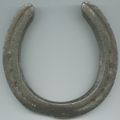Horseshoe
Horseshoe Kidney is a rare congenital disorder that affects the kidneys. This condition is characterized by the fusion of the kidneys at the lower end or base, forming a U-shape or a horseshoe shape.
Overview[edit]
Horseshoe Kidney is a type of renal fusion anomaly, a term that refers to a range of conditions in which the kidneys are joined together. It is the most common type of renal fusion anomaly. The condition occurs during fetal development when the kidneys, instead of separating as they usually do, remain connected at the lower end or base. This results in a single, horseshoe-shaped kidney that is located at the base of the spine.
Symptoms[edit]
Most individuals with Horseshoe Kidney do not have any symptoms and the condition is often discovered during tests for other conditions. However, some people may experience symptoms such as pain, urinary tract infections, kidney stones, and hydronephrosis (swelling of a kidney due to a build-up of urine).
Causes[edit]
The exact cause of Horseshoe Kidney is unknown. It is thought to occur randomly during fetal development. However, some studies suggest that genetic factors may play a role.
Diagnosis[edit]
Horseshoe Kidney is typically diagnosed through imaging tests such as ultrasound, CT scan, or MRI. These tests can show the abnormal shape and position of the horseshoe kidney.
Treatment[edit]
Treatment for Horseshoe Kidney is usually not necessary unless the individual is experiencing symptoms or complications. In such cases, treatment may include medications to manage pain and infections, procedures to remove kidney stones, or surgery to correct the position of the kidney or to treat complications.
See Also[edit]
|
|
|
-
Horseshoe
-
Variety of horseshoes, including aluminum racing plates and shoes used on cattle in lower right
-
Hipposandal
-
Horseshoes from C11
-
Horseshoemaker
-
Easyboot
-
Tule horseshoe
-
Horseshoe lucky on door
-
An illustration in 'The True Legend of St. Dunstan and the Devil'
-
Rutland County Flag
Ad. Transform your life with W8MD's Budget GLP-1 injections from $75


W8MD offers a medical weight loss program to lose weight in Philadelphia. Our physician-supervised medical weight loss provides:
- Weight loss injections in NYC (generic and brand names):
- Zepbound / Mounjaro, Wegovy / Ozempic, Saxenda
- Most insurances accepted or discounted self-pay rates. We will obtain insurance prior authorizations if needed.
- Generic GLP1 weight loss injections from $75 for the starting dose.
- Also offer prescription weight loss medications including Phentermine, Qsymia, Diethylpropion, Contrave etc.
NYC weight loss doctor appointmentsNYC weight loss doctor appointments
Start your NYC weight loss journey today at our NYC medical weight loss and Philadelphia medical weight loss clinics.
- Call 718-946-5500 to lose weight in NYC or for medical weight loss in Philadelphia 215-676-2334.
- Tags:NYC medical weight loss, Philadelphia lose weight Zepbound NYC, Budget GLP1 weight loss injections, Wegovy Philadelphia, Wegovy NYC, Philadelphia medical weight loss, Brookly weight loss and Wegovy NYC
|
WikiMD's Wellness Encyclopedia |
| Let Food Be Thy Medicine Medicine Thy Food - Hippocrates |
Medical Disclaimer: WikiMD is not a substitute for professional medical advice. The information on WikiMD is provided as an information resource only, may be incorrect, outdated or misleading, and is not to be used or relied on for any diagnostic or treatment purposes. Please consult your health care provider before making any healthcare decisions or for guidance about a specific medical condition. WikiMD expressly disclaims responsibility, and shall have no liability, for any damages, loss, injury, or liability whatsoever suffered as a result of your reliance on the information contained in this site. By visiting this site you agree to the foregoing terms and conditions, which may from time to time be changed or supplemented by WikiMD. If you do not agree to the foregoing terms and conditions, you should not enter or use this site. See full disclaimer.
Credits:Most images are courtesy of Wikimedia commons, and templates, categories Wikipedia, licensed under CC BY SA or similar.
Translate this page: - East Asian
中文,
日本,
한국어,
South Asian
हिन्दी,
தமிழ்,
తెలుగు,
Urdu,
ಕನ್ನಡ,
Southeast Asian
Indonesian,
Vietnamese,
Thai,
မြန်မာဘာသာ,
বাংলা
European
español,
Deutsch,
français,
Greek,
português do Brasil,
polski,
română,
русский,
Nederlands,
norsk,
svenska,
suomi,
Italian
Middle Eastern & African
عربى,
Turkish,
Persian,
Hebrew,
Afrikaans,
isiZulu,
Kiswahili,
Other
Bulgarian,
Hungarian,
Czech,
Swedish,
മലയാളം,
मराठी,
ਪੰਜਾਬੀ,
ગુજરાતી,
Portuguese,
Ukrainian













